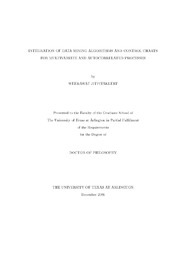
ATTENTION: The works hosted here are being migrated to a new repository that will consolidate resources, improve discoverability, and better show UTA's research impact on the global community. We will update authors as the migration progresses. Please see MavMatrix for more information.
Show simple item record
| dc.contributor.author | Jitpitaklert, Weerawat | en_US |
| dc.date.accessioned | 2010-03-03T23:30:27Z | |
| dc.date.available | 2010-03-03T23:30:27Z | |
| dc.date.issued | 2010-03-03T23:30:27Z | |
| dc.date.submitted | January 2009 | en_US |
| dc.identifier.other | DISS-10411 | en_US |
| dc.identifier.uri | http://hdl.handle.net/10106/2002 | |
| dc.description.abstract | The objective of this dissertation is to integrate state-of-the-art data mining algorithms with statistical process control (SPC) tools to achieve efficient monitoring in multivariate and autocorrelated process. Process monitoring and diagnosis have been widely recognized as important and critical tools in system monitoring for detection of abnormal behavior and quality improvement. Although traditional SPC tools are effective in simple manufacturing processes that generate a small volume of independent data, these tools are not capable of handling the large streams of multivariate and autocorrelated data found in modern manufacturing/service systems. As the limitations of SPC methodology become increasingly obvious in the face of ever more complex processes, data mining algorithms, because of their proven capabilities to effectively analyze and manage large amounts of data, have the potential to resolve the challenging problems that are stretching SPC to its limits. This dissertation consists of two main components; data mining model-based control charts and one-class classification-based control charts. First, we propose a new control chart technique that integrates state-of-the-art data mining algorithms with SPC techniques to achieve efficient monitoring in multivariate and autocorrelated processes. The data mining algorithms include artificial neural networks, support vector regression, and multivariate adaptive regression splines. The residuals of data mining models were utilized to construct multivariate cumulative sum control charts to monitor the process mean. Simulation results from various scenarios indicated that data mining model-based control charts performs better than traditional model-based control charts. Second, we examine the feasibility of using one-class classification-based control charts to handle autocorrelated multivariate processes. In recent years, statistical process control (SPC) of multivariate and autocorrelated processes has received a great deal of attention. Modern manufacturing/service systems with more advanced technology and higher production rates can generate complex processes in which consecutive observations are dependent and each variable is correlated. These processes obviously violate the assumption of the independence of each observation that underlies traditional SPC and thus deteriorate the performance of its traditional tools. The popular way to address this issue is to monitor the residuals with the traditional SPC approach. However, this residuals-based approach requires an accurate prediction model necessary to obtain the uncorrelated residuals. Furthermore, these residuals are not the original values of the observations and consequently may have lost some useful information about the targeted process. We use simulated data to present an analysis and comparison of one-class classification-based control charts and the traditional Hotelling's T2 chart. | en_US |
| dc.description.sponsorship | Kim, Seoung Bum | en_US |
| dc.language.iso | EN | en_US |
| dc.publisher | Industrial & Manufacturing Engineering | en_US |
| dc.title | Integration Of Data Mining Algorithms And Control Charts For Multivariate And Autocorrelated Processes | en_US |
| dc.type | Ph.D. | en_US |
| dc.contributor.committeeChair | Kim, Seoung Bum | en_US |
| dc.degree.department | Industrial & Manufacturing Engineering | en_US |
| dc.degree.discipline | Industrial & Manufacturing Engineering | en_US |
| dc.degree.grantor | University of Texas at Arlington | en_US |
| dc.degree.level | doctoral | en_US |
| dc.degree.name | Ph.D. | en_US |
Files in this item
- Name:
- Jitpitaklert_uta_2502D_10411.pdf
- Size:
- 738.9Kb
- Format:
- PDF
This item appears in the following Collection(s)
Show simple item record


